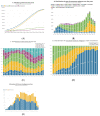Cohort Profile: A European Multidisciplinary Network for the Fight against HIV Drug Resistance (EuResist Network)
- PMID: 37235291
- PMCID: PMC10222321
- DOI: 10.3390/tropicalmed8050243
Cohort Profile: A European Multidisciplinary Network for the Fight against HIV Drug Resistance (EuResist Network)
Abstract
The EuResist cohort was established in 2006 with the purpose of developing a clinical decision-support tool predicting the most effective antiretroviral therapy (ART) for persons living with HIV (PLWH), based on their clinical and virological data. Further to continuous extensive data collection from several European countries, the EuResist cohort later widened its activity to the more general area of antiretroviral treatment resistance with a focus on virus evolution. The EuResist cohort has retrospectively enrolled PLWH, both treatment-naïve and treatment-experienced, under clinical follow-up from 1998, in nine national cohorts across Europe and beyond, and this article is an overview of its achievement. A clinically oriented treatment-response prediction system was released and made available online in 2008. Clinical and virological data have been collected from more than one hundred thousand PLWH, allowing for a number of studies on the response to treatment, selection and spread of resistance-associated mutations and the circulation of viral subtypes. Drawing from its interdisciplinary vocation, EuResist will continue to investigate clinical response to antiretroviral treatment against HIV and monitor the development and circulation of HIV drug resistance in clinical settings, along with the development of novel drugs and the introduction of new treatment strategies. The support of artificial intelligence in these activities is essential.
Keywords: HIV; HIV subtypes; antiretroviral therapy; drug resistance; treatment-response prediction system.
Conflict of interest statement
The funders had no role in the design of the study; in the collection, analyses, or interpretation of data; in the writing of the manuscript; or in the decision to publish the results. The authors declare no conflict of interest related to this article.
Figures



References
-
- UNAIDS Global HIV & AIDS Statistics—2021 Fact Sheet. [(accessed on 13 March 2023)]. Available online: https://www.unaids.org/sites/default/files/media_asset/UNAIDS_FactSheet_....
-
- Smith C.J., Ryom L., Weber R., Morlat P., Pradier C., Reiss P., Kowalska J.D., de Wit S., Law M., el Sadr W., et al. Trends in underlying causes of death in people with HIV from 1999 to 2011 (D:A:D): A multicohort collaboration. Lancet. 2014;384:241–248. doi: 10.1016/S0140-6736(14)60604-8. - DOI - PubMed
-
- Alejos B., Hernando V., Lopez-Aldeguer J., Segura F., Oteo J.A., Rubio R., Sanvisens A., Sobrino P., Del Amo J., Coris C. Overall and cause-specific mortality in HIV-positive subjects compared to the general population. J. Int. Aids Soc. 2014;17:19711. doi: 10.7448/IAS.17.4.19711. - DOI - PMC - PubMed
-
- EACS Guidelines Version 11.1, October. [(accessed on 13 March 2023)]. Available online: https://www.eacsociety.org/media/guidelines-11.1_final_09-10.pdf.
-
- Panel on Antiretroviral Guidelines for Adults and Adolescents Guidelines for the Use of Antiretroviral Agents in Adults and Adolescents with HIV. Department of Health and Human Services. [(accessed on 13 March 2023)]; Available online: https://clinicalinfo.hiv.gov/en/guidelines/adult-and-adolescent-arv.
Grants and funding
LinkOut - more resources
Full Text Sources

